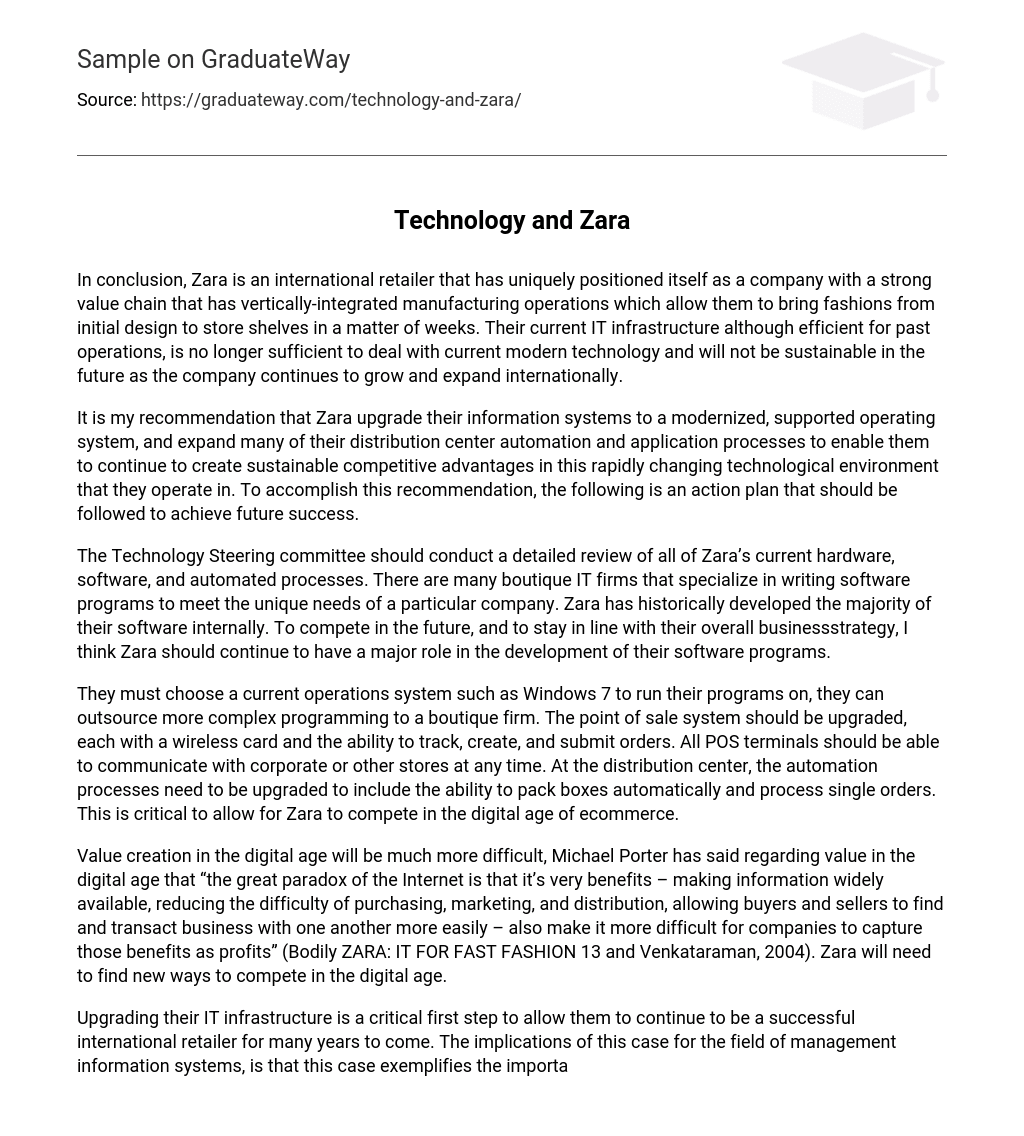In conclusion, Zara is an international retailer that has uniquely positioned itself as a company with a strong value chain that has vertically-integrated manufacturing operations which allow them to bring fashions from initial design to store shelves in a matter of weeks. Their current IT infrastructure although efficient for past operations, is no longer sufficient to deal with current modern technology and will not be sustainable in the future as the company continues to grow and expand internationally.
It is my recommendation that Zara upgrade their information systems to a modernized, supported operating system, and expand many of their distribution center automation and application processes to enable them to continue to create sustainable competitive advantages in this rapidly changing technological environment that they operate in. To accomplish this recommendation, the following is an action plan that should be followed to achieve future success.
The Technology Steering committee should conduct a detailed review of all of Zara’s current hardware, software, and automated processes. There are many boutique IT firms that specialize in writing software programs to meet the unique needs of a particular company. Zara has historically developed the majority of their software internally. To compete in the future, and to stay in line with their overall businessstrategy, I think Zara should continue to have a major role in the development of their software programs.
They must choose a current operations system such as Windows 7 to run their programs on, they can outsource more complex programming to a boutique firm. The point of sale system should be upgraded, each with a wireless card and the ability to track, create, and submit orders. All POS terminals should be able to communicate with corporate or other stores at any time. At the distribution center, the automation processes need to be upgraded to include the ability to pack boxes automatically and process single orders. This is critical to allow for Zara to compete in the digital age of ecommerce.
Value creation in the digital age will be much more difficult, Michael Porter has said regarding value in the digital age that “the great paradox of the Internet is that it’s very benefits – making information widely available, reducing the difficulty of purchasing, marketing, and distribution, allowing buyers and sellers to find and transact business with one another more easily – also make it more difficult for companies to capture those benefits as profits” (Bodily ZARA: IT FOR FAST FASHION 13 and Venkataraman, 2004). Zara will need to find new ways to compete in the digital age.
Upgrading their IT infrastructure is a critical first step to allow them to continue to be a successful international retailer for many years to come. The implications of this case for the field of management information systems, is that this case exemplifies the importance of how technology can affect your business model and your success as a business. Zara has been able to use technology to their advantage. Their unique software and automated processing provides value to their business. For any company to compete in today’s business world, they must use technology in a way that brings value to their bottom line.
Recommendations
Zara’s e-commerce site, Zara.com earns nothing short of an A in its aesthetic appeal, site navigation, product offerings, shipping, returns and company policies. However, there are a few recommendations for Zara that can further enhance the consumer shopping experience. The first recommendation would be a more detailed paragraph on the company’s “About Us” page . It is easier to find detailed information on Zara and its culture on external sources than it is on the home site. Zara’s “About Us” expresses nothing about the company culture or brand image for consumer’s who ever visited its brick and mortar store because of its lack of presence in the consumer’s state or city. Instead, Zara’s “About Us” page simply states that “Zara is one of the largest international fashion companies. It belongs to Inditex, one of the world’s largest distribution groups.” ( ” C o m p a n y , ” 2 01 0 )
Second recommendation would be to include the merchandise and model specification in terms of item length, neckline length, model height, size worn by model etc. This feature would minimize the amount of returns or exchanges issued. The final recommendation would to offer working mobile applications. Though, Zara does offer a mobile application, it has often been reviewed as nearly useless by iPhone , Blackberry and other Smartphone users who have downloaded the app. The company could benefit through this mobile venue since an increasing amount of shoppers making purchases via Smartphone.





